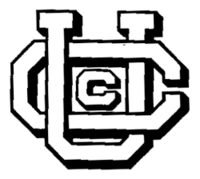Utah Construction Company

Utah Construction Logo from 1900 - 1958

Utah Construction Logo from 1959 - 1970

Utah International Logo after acquisition by BHP
The Utah Construction Company was a construction company founded by Edmund Orson Wattis Jr., Warren L. Wattis and William. H. Wattis in 1900.[1][2]
Contents
1 History
2 References
3 Sources
4 External links
History
A short four years after its founding, the company was awarded the contract to build the Feather River train route between Oakland and Salt Lake City. This $60 million contract was challenging, but after five years, very profitable. The Feather River route was completed for the Western Pacific Railroad in 1911. The Utah Construction Company thrived, and soon captured a large share of the tunneling, grading, and track projects for the rapidly expanding railroads in the mountain west. Seeing the end of railroad expansion, the Wattis Brothers looked for ways to diversify their construction risks.
In 1917, Utah Construction Company was awarded the $7 million O'Shaughnessy Dam contract, a controversial project that impounds the Tuolumne River in the Hetch Hetchy Valley of California's Sierra Nevada mountains. Success with the O'Shaughnessy Dam convinced the Wattis Brothers to bid on more dam projects. In 1922, Utah Construction Company formed a partnership with the Morrison-Knudsen Company of Boise. With Frank Crowe as the chief engineer, the MK-UC partnership successfully built dams throughout the American west.
In 1931, the Wattis Brothers spearheaded the formation of Six Companies to build the Hoover Dam which was the largest construction project ever tackled by the US Government up to the time. Including the Hoover Dam, Utah Construction built 58 dams between 1916 and 1969.[3]
In 1942, several weeks after the Japanese bombing of Pearl Harbor, Japanese warships were sighted in Alaskan waters. No overland route existed connecting Alaska with the contiguous United States. This situation spurred the American Government to plan and build the Alaskan Army Highway, later renamed the Alaska Highway. US Army and civilian contractors, led by Utah Construction, completed the 1,500 miles (2,400 km) arctic highway in just seven months and 17 days.
In the 1950s, Utah Construction diversified into mining, becoming the Utah Construction & Mining Co. These ventures included the Marcona iron mine in Peru, the Lucky Mc uranium mine in Wyoming, and the Navajo coal mine and power plant in the Four Corners area of the United States southwest.
Utah Construction also diversified into land development. Through a series of acquisitions, Utah Construction purchased the Moraga Ranch in the San Francisco Bay Area. This 3,000 acre (12 km²) ranch was developed into Moraga, California. Utah also filled in 400 acres (1.6 km2) of the San Francisco Bay to create much of the area of present-day south shore in Alameda.
The 1960s brought further military construction with Utah Construction the lead contractor for the US Minuteman Missile hardened silos throughout the United States as well as Construction of the Cheyenne Mountain Complex in Colorado Springs.
In 1969, Utah Construction went public on the New York Stock Exchange with the symbol UC. The construction business was sold to the Fluor Corporation in 1969. In 1971, the company changed its name to Utah International. The company merged with the General Electric company in 1976 for a value of over $2.2 billion, the largest corporate merger in history at that time. It continued to operate as a distinct entity however, and in 1984 GE sold the company to BHP.
The Wattis Brothers received funding from the David Eccles, Thomas D. Dee,[2]Joseph Clark and James Pingree family. Thomas D. Dee served as the first president of Utah Construction until his death in 1905, David Eccles served as the second president, and David Eccels' son Marriner Stoddard Eccles became the president of Utah Construction concurrently with being the Federal Reserve Chairman. The shareholders and Val A. Browning acquired the shares of Warren Wattis in the 1940s. The Wattis Brothers original $8,000 investment, in 1900, grew to $478 million after the 1976 acquisition by the General Electric company.
References
^ Sarah Langsdon; Melissa Johnson (2012). Legendary Locals of Ogden. Arcadia Publishing. p. 14-15. ISBN 978-1-4671-0030-4..mw-parser-output cite.citation{font-style:inherit}.mw-parser-output q{quotes:"""""""'""'"}.mw-parser-output code.cs1-code{color:inherit;background:inherit;border:inherit;padding:inherit}.mw-parser-output .cs1-lock-free a{background:url("//upload.wikimedia.org/wikipedia/commons/thumb/6/65/Lock-green.svg/9px-Lock-green.svg.png")no-repeat;background-position:right .1em center}.mw-parser-output .cs1-lock-limited a,.mw-parser-output .cs1-lock-registration a{background:url("//upload.wikimedia.org/wikipedia/commons/thumb/d/d6/Lock-gray-alt-2.svg/9px-Lock-gray-alt-2.svg.png")no-repeat;background-position:right .1em center}.mw-parser-output .cs1-lock-subscription a{background:url("//upload.wikimedia.org/wikipedia/commons/thumb/a/aa/Lock-red-alt-2.svg/9px-Lock-red-alt-2.svg.png")no-repeat;background-position:right .1em center}.mw-parser-output .cs1-subscription,.mw-parser-output .cs1-registration{color:#555}.mw-parser-output .cs1-subscription span,.mw-parser-output .cs1-registration span{border-bottom:1px dotted;cursor:help}.mw-parser-output .cs1-hidden-error{display:none;font-size:100%}.mw-parser-output .cs1-visible-error{font-size:100%}.mw-parser-output .cs1-subscription,.mw-parser-output .cs1-registration,.mw-parser-output .cs1-format{font-size:95%}.mw-parser-output .cs1-kern-left,.mw-parser-output .cs1-kern-wl-left{padding-left:0.2em}.mw-parser-output .cs1-kern-right,.mw-parser-output .cs1-kern-wl-right{padding-right:0.2em}
^ ab Ronald E. Bromley (January 14, 2013). The last train to leave Cimarron, New Mexico: Why the trains left Cimarron. AuthorHouse. p. 31. ISBN 978-1-4817-0002-3.
^ Herman, Arthur. Freedom's Forge: How American Business Produced Victory in World War II, pp. 52, 57, Random House, New York, NY, 2012.
ISBN 978-1-4000-6964-4.
Sources
- Sessions, Gene & Sterling. Utah International, A Biography of a Business.
ISBN 0-9722102-0-2
External links
- Wattis brothers, Hoover Dam History
- Stewart Library Collection, Utah Construction
A Guide to the Utah Construction Company Records, 2009-16. Special Collections, University Libraries, University of Nevada, Reno.